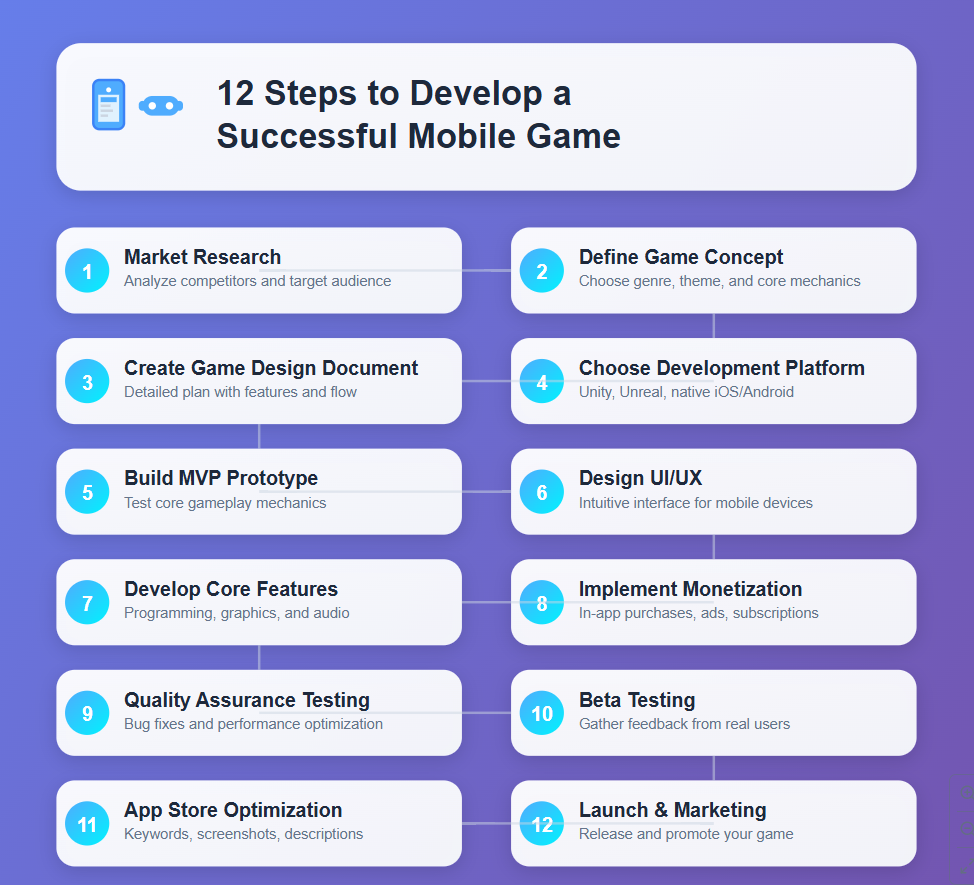Almost every gamer has, at some point, imagined creating their own game. Sometimes, even well-known studios fail to deliver because they overlook the core principles of building a successful project. The truth is: you don’t need a huge budget to build a game millions of players will love—you need the right process, awareness of the gaming market, and a solid grasp of fundamentals.
When a game connects with its audience, marketing almost becomes optional. Word-of-mouth alone can push it to the top. In this guide, we’ll walk through the 12 essential steps of mobile game development, explain why mobile gaming is so profitable, highlight common mistakes to avoid, and share expert-driven insights for new developers.
Why Mobile Games Are So Profitable
The mobile gaming industry is booming. With over 3 billion players worldwide, and nearly half choosing mobile as their primary platform, the demand is massive. Why?
-
Accessibility: Games are always in your pocket.
-
New tech: VR, AR, and AI are now accessible on mobile.
-
Variety: From casual puzzles to competitive esports, mobile caters to all.
Players turn to games to relax, escape daily stress, or simply pass the time. That means the right idea, executed well, has a huge chance to reach millions. The key is combining a fun concept with smart monetization.
12 Steps to Develop a Successful Mobile Game

Step 1: Come Up With a Great Idea
Every project starts with a core idea. The best games solve a “gap” in the market—something players want but don’t yet have. Study trends, analyze why certain games succeed, and think like a player. Strong stories, replay value, and simple but engaging mechanics are what often drive success.
Step 2: Define a Unique Game Concept
A concept isn’t just the idea—it’s the foundation of the project. Define:
-
What the game is about.
-
Its mechanics and goals.
-
Platforms it will run on.
-
Video game genre, style, and audience.
Market research here is critical. A clear concept becomes your project’s blueprint.
Step 3: Select a Mobile Game Platform
iOS or Android—or both? Developing for multiple platforms widens reach but increases cost and workload. If budget allows, go cross-platform for maximum downloads and profit.
Step 4: Choose a Game Engine
The game engine is the heartbeat of development. It determines how graphics, physics, and gameplay are built. Popular options include:
-
Unity – Flexible, beginner-friendly.
-
Unreal Engine – Known for high-end graphics.
-
CryEngine – Realistic visuals, great for immersive worlds.
-
Godot – Lightweight and open-source.
Pair your engine with the right programming language (C#, C++, Python, etc.) for full control.
Step 5: Build a Game Design Document (GDD)
Think of the GDD as your game’s bible. It should detail storylines, mechanics, characters, levels, assets, and technologies. Keep it updated as development evolves—this ensures clarity across your team.
Step 6: Design Game Structure
Players are drawn to visual appeal and smooth gameplay. Decide whether you’re building in 2D or 3D. Align visuals with your concept, story, and audience. Great design improves retention and download rates.
Step 7: Plan the Wireframe
The wireframe visualizes your game’s structure before coding. It acts like a storyboard for how users interact with the game, making it easier to spot potential flaws early.
Step 8: Write the Code
Now the real work begins. Choose your language carefully and bring the concept to life with clean, efficient coding. This stage is where sketches, designs, and mechanics transform into a playable product.
Step 9: Test Thoroughly
Testing is critical. Outsiders—not just developers—should test the game to provide honest first impressions. Game testing helps reveal bugs, performance issues, or confusing mechanics that could ruin player experience.
Step 10: Choose a Monetization Strategy
Monetization drives sustainability. Options include:
-
In-app purchases (skins, upgrades).
-
Ads (rewarded or interstitial).
-
Premium/paid games (less common today).
-
Demo-to-paid versions.
-
Real-money mechanics (coins, loot).
The best model balances profit without frustrating players.
Step 11: Launch the Game
After testing and polishing, submit to app stores. Remember: each store has a review process, and approval isn’t guaranteed. Make sure your app complies with guidelines and is well-optimized for devices.
Step 12: Post-Release Support & Updates
Launch isn’t the end. To keep players engaged:
-
Add fresh content (skins, levels, events).
-
Fix bugs quickly.
-
Maintain 24/7 customer support.
Games that evolve over time (like Clash of Clans or PUBG Mobile) keep audiences loyal for years, like the old Facebook games.
Common Mistakes in Mobile Game Development
Even good ideas fail if execution goes wrong. Avoid these pitfalls:
-
Feature overload: Don’t launch with everything at once. Roll out updates gradually.
-
Poor retention strategy: If you don’t update, players leave.
-
Weak promotion: Even the best game fails without marketing.
-
Underestimating team quality: Hiring inexperienced developers can cost time, money, and reputation. Outsourcing or building a skilled in-house team is essential.
Final Thoughts
Mobile game development is a long, detailed process, but with the right plan, it’s achievable—even for beginners. The most successful games aren’t just entertaining; they solve a need, hook players emotionally, and evolve over time.
Follow these 12 steps, avoid the common mistakes, and you’ll be well on your way to building a mobile game that doesn’t just launch—but thrives.






